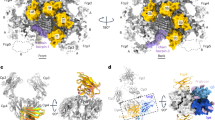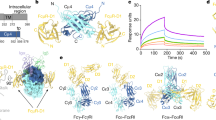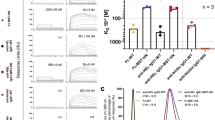Abstract
MEMBRANE receptors recognising the Fc portion of immunoglobulin molecules (Fc receptors) are found in many cells of the immune system1–4. Fc receptors on lymphocytes are readily detected by a rosette test3,5,6 and this reaction is inhibited by pretreatment of the lymphocytes with IgG (ref. 3). IgG proteins lacking almost the entire CH1 and CH3 homology regions have been obtained from mutant cell lines of MOPC 21, a plasmacytoma secreting IgG1 (refs 7 and 8) and the extent of the deletions determined (Fig. 1). To identify that part of the IgG molecule which interacts with the Fc receptor, we have tested the ability of these IgG proteins to inhibit Fc rosette formation on murine lymph node cells. We show (Table 1) that an intact CH3 region is essential for the binding of IgG to Fc receptors on lymph node cells.
This is a preview of subscription content, access via your institution
Access options
Subscribe to this journal
Receive 51 print issues and online access
$199.00 per year
only $3.90 per issue
Buy this article
- Purchase on SpringerLink
- Instant access to full article PDF
Prices may be subject to local taxes which are calculated during checkout
Similar content being viewed by others
References
Basten, A. B., Miller, J. F. A. P., Sprent, J., and Pye, J., J. exp. Med., 135, 610–626 (1972).
Bloch, K. J., Prog. Allergy, 10, 84–150 (1967).
Cline, M. J., Sprent, J., Warner, N. L., and Harris, A. W., J. Immunol., 108, 1126–1128 (1972).
Lay, W. H., and Nussenweig, V., J. exp. Med., 128, 991–1009 (1968).
Hallberg, T., Gurner, B. W., and Coombs, R. R. A., Int. Archs Allergy appl. Immun., 44, 500–513 (1974).
Ramasamy, R., and Munro, A. J., Immunology, 26, 563–570 (1974).
Cotton, R. G. H., Secher, D. S., and Milstein, C., Eur. J. Immunol., 3, 135–140 (1973).
Milstein, C., Adetugbo, K., Cowan, N. J., and Secher, D. S., in Progress in Immunology, 2 (edit. by Brent, L., and Holborow, E. J.), 157–168 (North-Holland, Amsterdam, 1974).
Froland, S. S., Natvig, J. B., and Stavem, P., Scand. J. Immunol., 1, 351–360 (1972).
Edelman, G. M., Cunningham, B. A., Gall, W. E., Gottlieb, P. D., Rutishauser, U., and Waxdal, M. J., Proc. natn. Acad. Sci. U.S.A., 63, 78–85 (1969).
Kehoe, J. M., and Fougereau, M., Nature, 224, 1212–1213 (1969).
Okafor, G. O., Turner, M. W., and Hay, F. C., Nature, 248, 228–230 (1974).
Yasmeen, D., Ellerson, J. R., Dorrington, K. J., and Painter, R. M., J. Immunol., 110, 1706–1709 (1973).
MacLennan, I. C. M., Connel, G. E., and Gotch, F. M., Immunology, 26, 303–310 (1974).
Ramasamy, R., Munro, A. J., and Milstein, C., Nature, 249, 573–574 (1974).
Secher, D. S., Cotton, R. G. H., and Milstein, C., FEBS Lett., 37, 311–316 (1973).
Author information
Authors and Affiliations
Rights and permissions
About this article
Cite this article
RAMASAMY, R., SECHER, D. & ADETUGBO, K. CH3 domain of IgG as binding site to Fc receptor on mouse lymphocytes. Nature 253, 656 (1975). https://doi.org/10.1038/253656a0
Received:
Revised:
Published:
Issue date:
DOI: https://doi.org/10.1038/253656a0
This article is cited by
-
Molecular analysis of spontaneous somatic mutants
Nature (1977)



